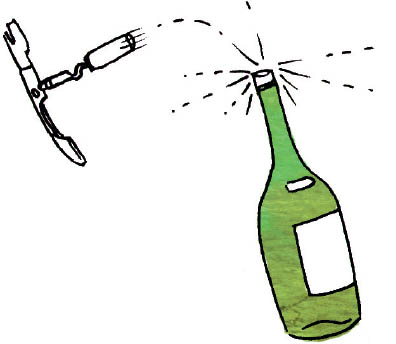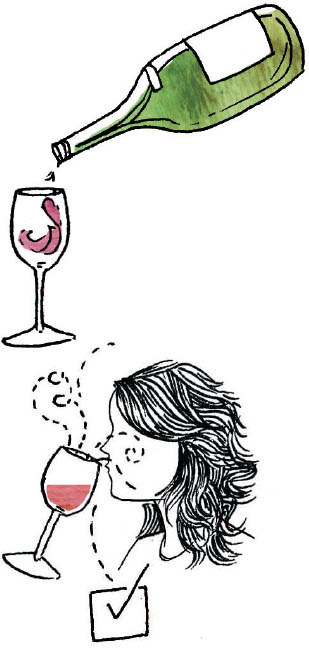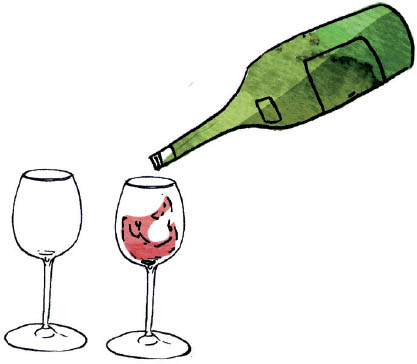
Now you understand that this adventure will be a long and wonderful one. What next? With wine, as with many things in life, feeling self-assured is half the battle. And, no, that doesn’t mean you need to get all snooty—wine is just as at home at a backyard barbecue as it is in the finest French restaurants. Just like if you were learning a new sport, you’re going to need some essential equipment, basic vocabulary words, and a few pointers before you take in the subtleties of the game. The following steps will empower you to get your wine on, confidently.

WAITER’S CORKSCREW
Unlike golf or skiing, starting a wine habit— I mean, hobby—is really not that expensive. You can spend a fortune on wine, but you don’t need to. Here are the essentials to get you going.
As long as wineries are using corks to close their wine bottles, you’re going to need a device to get that puppy open. You could add drama by sabering the top of the bottle off with a sword. This method may impress dates, but it will inevitably end with a big mess. Since pulling out your sword on the first date is probably not a great idea anyway, the safest bet—however boring it may be—is to stick with a corkscrew. There are many types of corkscrews. Use whichever one you feel most comfortable with.
Basic Corkscrew The basic corkscrew features a handle with a simple, spiraling screw (also called a worm). If your biceps leave something to be desired, I’d avoid this one. Lack of leverage is a real pain.
Waiter’s Corkscrew Add leverage and control to the basic corkscrew and you have a great tool. This opener also often includes a handy foil cutter, it’s easy to transport, and it’s inexpensive. It’s my personal favorite, but you may need a little practice to master it.
Did You Know? Only about 50 percent of American households own a corkscrew. / Barron’s
Butterfly or Wing Corkscrew The butterfly combines a corkscrew with a bottle cap opener—a good feature to point out to your beer-drinking friends, who may worry you’ve abandoned them for a wine-only lifestyle.

BUTTERFLY CORKSCREW
Self-Pulling Corkscrew This design consists of a basic corkscrew fitted into a plastic guide. It gets the job done with most corks, but it can be difficult with plastic corks and fragile corks (like the ones you might discover in an older wine, when time has deteriorated the natural material).
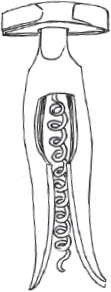
SELF-PULLING CORKSCREW
Cork-Pulling Machine (e.g., the “Rabbit”) This is the Hummer of corkscrews. The Rabbit, and other copycat openers, have two gripping handles that latch on to the top of a wine bottle and a top lever that drives the worm into the cork and pops it out. They are easy to use, but can lack the finesse you sometimes need to remove troublesome corks, and they can be quite a bit more expensive than any of the other corkscrews.
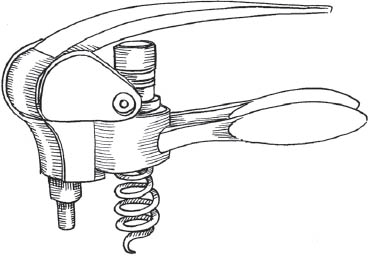
CORK-PULLING MACHINE
Ah-So You’ll find this tool in the pocket of most top sommeliers because it is great for old or injured corks; it won’t puncture brittle corks and it can masterfully extract a cork that’s been mangled by one of the other tools. The Ah-So is like a cork ambulance—excellent in an emergency, but not necessary or practical for everyday transportation.
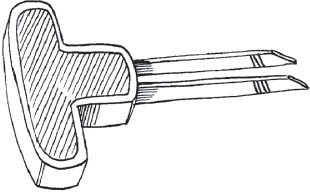
AH-SO
Colorful plastic wineglasses are one of the best inventions ever conceived. Drink wine on the beach, at the pool, or in a boat without the fear of breaking an expensive glass? Brilliant idea. However, for times when you are drinking wine to learn, you need serious glasses. The best are made of thin, clear crystal, with a largish bottom that curves, narrowing at the top.
I promise good glasses make a huge difference—not only in the aesthetic pleasure you can derive from drinking out of a beautiful vessel, but also how it technically affects the taste of the wine. Studies on taste and smell from the Yale School of Medicine have proved that flavors can be perceived as more or less pleasurable based on where they specifically land in your mouth. Glasses designed with that in mind can (at least theoretically) deliver wine optimally. If this is all sounding a little too geeky, it is. Just like serious cyclists can get fanatical about having the lightest possible carbon fiber bike or the golfer who’s crazed with the exact angle of his driver, you can get obsessed with having the perfect wineglass for every type of wine. Riedel, one of the oldest and best wineglass-making companies, makes more than two hundred fifty types of wineglasses, many specific to certain grapes or regions. For most people, me included, buying a nice set of one large size will do. Admittedly, when I’m at home, I usually drink most wines—white, red, and pink—out of the same glass.
For wines with bubbles, I typically use a tall flute with a slightly larger bowl than lip. Tulip-shaped flutes also work well. Again, thin, clear crystal is best.
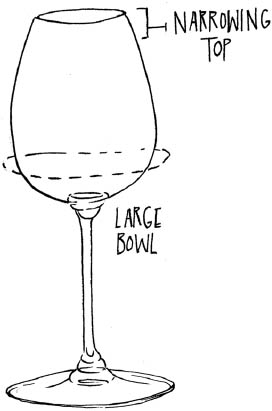
AN IDEAL ALL-PURPOSE WINE GLASS
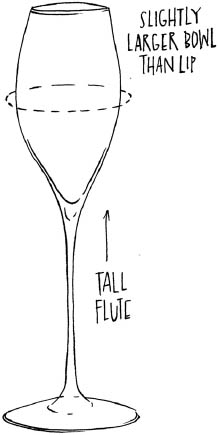
AN IDEAL CHAMPAGNE FLUTE
Flutes are gorgeous and elegant, but they are not absolutely necessary to enjoy sparkling wine. Wine professionals sometimes use a regular wineglass to evaluate Champagne or sparkling wine. In fact, I think you can smell sparkling wines better in a glass with a larger opening, but the bubbles fade faster, and it’s just not as fun.
The one glass I would never advise for sparkling wine is the Champagne coupe, or Champagne saucer, which legend says was modeled on the breast of Marie Antoinette.
This shallow (sorry, Marie) broad-bowled glass is a horrible vessel for delivering sparkling wine. The best parts of drinking sparkling wine are (a) savoring the aroma and (b) watching all those beautiful bubbles dance around in your glass. The broad surface area of the coupe allows both aroma and carbonation to escape quickly.
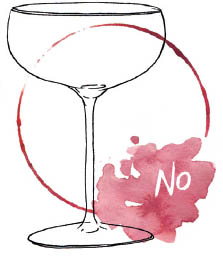
A wine carrier For wine on the go, you can’t beat the fun neoprene totes from Built (builtny.com). They make bringing a bottle to a restaurant, the park, or a friend’s house convenient and stylish.
Champagne stoppers On the rare occasion I cannot empty a bottle of sparkling wine, I find this little tool indispensable. It’s the best way to keep bubbles in the bottle a little longer—in between evenings, or even in between pours.
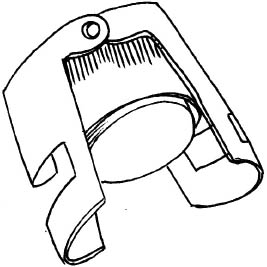
CHAMPAGNE STOPPER
Charms for glasses Washing wineglasses is decidedly un-fun. One way to ensure less dishwashing duty is to make sure nobody loses his or her glass. There are hundreds of options available for marking your wine territory, ranging from corny baubles to sleek tags.
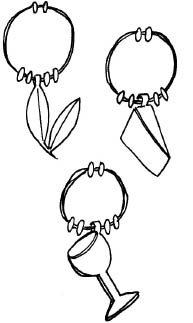
CHARMS FOR GLASSES
Wine culture is inextricably linked to a certain ceremonial showiness that can, regrettably, turn people off and alienate them from the otherwise humble beverage. Don’t fret. Things have changed and there are really no rules when it comes to imbibing. While some of those little rituals you’ve seen or heard of are more for show, some are actually useful and have real scientific purpose.
It prevents the glass from getting dirty and ensures you don’t raise the temperature of the wine with your hot little hands. Temperature plays a substantial role in how a wine tastes—the hotter the wine, the more we taste the alcohol and the less we taste of everything else. (More on that later. See Temperature, page 130.)
This practice aerates, or adds oxygen to, the wine. Getting a little oxygen in your wine by swirling your glass allows the wine to breathe, so that it opens up and reveals its true aromas and flavors. The idea is to expose as much surface area of the wine as possible to oxygen. So swirl away!
Contrary to what you might think, a large, glass-filling pour is not a good one. When entertaining at home, fill the glass about halfway full, so you have plenty of room for swirling. If you’re using a decent glass (see “Good Glasses,” page 17), filling it halfway will still provide a substantial serving (3 or 4 fluid ounces).

TASTING POUR ~2 OZ
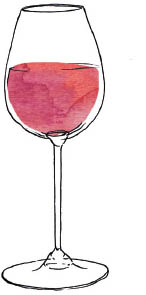
SERVING POUR ~4 OZ
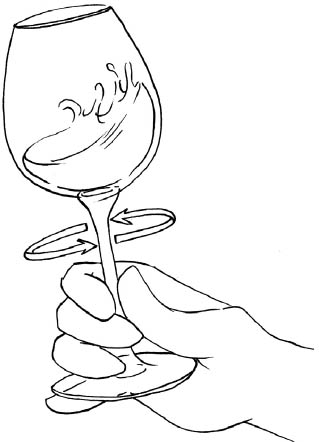
Relax—you don’t need to smell or fondle the cork. Proper etiquette is actually to just ignore it. Yes, a moist cork is an indicator that the wine was stored properly: on its side. (If a wine with a cork is stored upright for too long, the cork can shrink, allowing potentially damaging amounts of oxygen to seep into the bottle and ruin the wine.) A cork’s condition, however, is no clear indication of the wine’s condition. The only way to tell if a wine is happy and healthy is to smell the wine itself. Pristine corks can encapsulate flawed wine, just as you can pull a grimy, moldy, black-and-green mess of a cork out of an otherwise perfect bottle. Save the cork to remember the evening if you so desire. Otherwise, just forget about it.

The language of wine can be especially intimidating. From “malolactic fermentation” to “volatizing esters,” there’s a lot of sophisticated wine lingo rolling off the lips of those in the know, not to mention all the descriptors for tasting . . . roses and tar in your wine? Take a deep breath. It’s easy to get so bogged down in wine’s daunting vocabulary that you forget why you were interested in the first place—because it tastes good! Don’t worry. In time, you will master the vernacular. For now, if you have a good grasp of your ABTs—acidity, body, and tannin—you’ll be smarter than most.
Acidity is the razor-like tang running sharply through the core of wine. Acidity makes your mouth water. It’s a wine’s verve, zest, and vitality.
All fruits have acidity, some substantially more than others. When imagining acidity, think of fruits that make you pucker . . . the most iconic acidic fruit is a lemon, but other high-acid fruits include grapefruit, lime, and green apple. All wines have some measure of acidity. It comes naturally from the grape. As grapes ripen, acidity drops and sugars rise. The longer the sunbathing session and the warmer the weather, the lower the acidity in the finished wine. That’s why, no matter what the grape, warm places like southern Australia create wines with lower acidity, and cool regions like Germany and Austria generally produce wines with higher acidity.
Too much acidity can taste harsh, like it’s stripping the enamel off your teeth. Inadequate acidity makes wine taste flat, dull, and lifeless. Although you may prefer the tang of high acidity or the lush mouth-feel of wines that have very little acid, higher (but balanced) acidity is generally considered best. It tastes more refreshing, and it makes wine much more pleasant to drink with food. It is also a natural preservative that can add years to a wine’s shelf life.
A great body is a wonderful thing—when it comes to people and wine. But as with the human form, “great” is subjective. A wine’s body refers to its weight or viscosity. The more alcohol a wine has, the more body it will have. What exactly does a light-bodied wine feel like as opposed to a full-bodied wine? Like skim versus whole milk. A light-bodied wine isn’t quantifiably any better or worse than a full-bodied wine; it’s all just what you and your tongue prefer.

Here’s a guide to the body in some popular wines. Keep in mind that where the wine comes from, how it’s handled, and the weather of a given year can make a big difference in a wine’s body. (Some chardonnays seem light and airy, others heavy and thick.) And, for clarification purposes, grape names are lowercase and appellations (or place-names) are capitalized. This gives you an idea of where wines generally fall in relation to their peers.
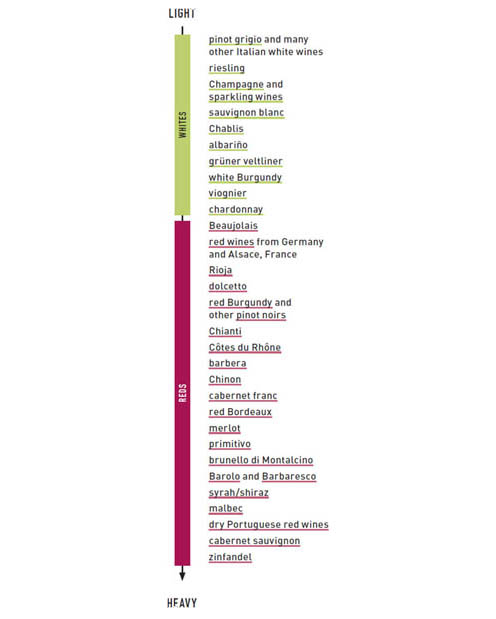
Wine that dries out your mouth? That’s tannin in action. If you’ve ever tasted oversteeped tea or can recall the bitter aftertaste of a walnut, you already know how tannin tastes and feels. In the case of grapes, tannin is a compound that comes mostly from the skins and seeds. (Some additional tannin can be derived from an extended stay in oak barrels.) It is most evident in red wines made from small, thick-skinned grapes, which equate to more tannin per volume of juice. Tannin not only dries out your mouth, but also provides a skeletal structure for the rest of the wine.
Like acidity, tannin is a natural preservative, and wines that are born with hard, massive tannins typically have a long life. Over time, those harsh, stiff-feeling tannins soften, feeling silkier. Instead of dominating the wine, they integrate with the other components. Catching tannins at their prime—when they are still present enough to provide backbone, but have mellowed enough to be drinkable—is more a game of luck than skill.
Did You Know? Wine’s calories come from alcohol, so a wine with more body has slightly more calories. Usually wines range from about 80 calories (light-bodied) to 120 calories (full-bodied) for a 4-ounce pour. / The Wine Institute
Whether perusing the aisles or scanning an unfamiliar restaurant list, these tips will help you make smart wine choices.
A wine store can make or break your love for wine, especially in the beginning. The worst wine stores are dusty, dispassionate places that care only about profit. Or they are havens for self-important wine clerks who know just enough about wine to make you feel inadequate. The best shops are vibrant places with an interesting selection, an impassioned slant on wine, and a knowledgeable, friendly staff that goes out of their way to help you choose wines that are right for your taste buds. I can’t emphasize enough how important it is to find a wine store you love and trust to help you along your wine journey. Once you find the right spot, committing to wine shop monogamy will give the resident experts the opportunity to get intimate with your palate.
How to Gauge the Integrity and Enthusiasm of a Wine Shop
Do they write about wine? Newsletters and blogs are a great way to judge a shop’s passion and position on wine. Does what they write ooze with excitement? That’s a good sign.
Do they host regular tastings, classes, or seminars? Providing opportunities for customers to taste and learn is another indicator of a shop’s fervor; it means they are eager to share and interact with their customers.
Are the bottles in the store clean, well organized, and well cared for? Just as you wouldn’t buy strawberries covered in dusty plastic, an unrefrigerated pork loin, or potatoes that were strewn across a supermarket floor, you want to make sure you’re buying wine that has been loved up.
It’s a wine store’s job to care for and mindfully market wines. They should put time and thought into it. The easiest way to judge wine care is to touch a bottle. It should be cool and clean. If bottles are warm and dusty, or the shelves lack organization, it’s probably best to shop elsewhere.
It’s a saying I live by, and it’s as true for wine shopping as it is for anything else. Get better at asking for what you want. It should be the driving factor for learning and understanding wine vocabulary. Even before you’re comfortable talking about particular flavors and aromas, just line up bottles and say, “I liked this, this, and this, but not this.” That information holds valuable clues to decoding your preferences. Anything you can communicate to your trusty wine shop clerk or sommelier—good or bad—will make the wine whizzes more useful to you; they’ll have the ammo they need to make good predictions of what you’ll enjoy next.
Did You Know? Women buy about 70 percent of the wine purchased in U.S. grocery stores, yet women account for less than 20 percent of the customers in fine wine shops. / Vineyard and Winery Management
Most wine stores offer a discount if you buy a case of twelve bottles at a time—and many don’t require that it be a dozen of the same bottles. Some shops offer discounts on six bottles.
Within the wine industry, it was once standard knowledge that the prettiest labels adorned the worst bottles of wine. They were heartless, profit-driven eye candy with catchy names and colorful images meant to grab your attention on deep, crowded wine shelves. More money was spent on marketing than on the wine. Authentic wines—those that spoke of a place and were crafted by loving hands—most often had the most innocuous labels. Boring and forgettable on the outside, marketing was an afterthought for these gems.
I am happy to say that all of that is changing now. The evil wine-marketing militia is still out there peddling a smorgasbord of brightly colored rainwater, but now the farmers and families realize that you need a little panache on the outside to compete.
The lesson? There are lots of cute labels out there; some of them actually contain decent wine. Let that trustworthy wine retailer guide you, especially if you’re going to spend a good deal of your hard-earned bucks on a bottle. Retailers should taste every wine that comes in the door. If they’re really good at what they do, their buying decisions should shelter you from the lackluster stuff.

Did You Know? Per capita, the United States has a lot of catching up to do when it comes to wine consumption. We only drink about two gallons each annually—compared with fifty-four gallons of soft drinks per person per year! Europe drinks us under the table; countries like Italy, France, and Portugal consume closer to thirteen or fourteen gallons of wine per person annually. / The Wine Institute
I have a theory that the best bang-for-your-buck bottles are in the thirty-to fifty-dollar range. This is the slowest category in wine retail, because consumers usually enter a wine shop knowing they want to spend a little (usually under twenty dollars) for everyday wine or a lot (more than seventy-five or one hundred) for a special occasion. Wine marketers know these stats, and price their wines accordingly, avoiding the dreaded no-man’s land in between the two price points. Wines priced in between that range are typically made by folks who are less concerned about the perception of price point (and how it affects sales), and are just charging what it actually costs them to produce the wine. Imagine that. Truth be told, I’m much more often blown away by forty- and fifty-dollar bottles than the ones that cost two hundred dollars.
Appellation: An appellation is the specific place that the wine comes from. For example, California is an appellation. So is Napa Valley. It is implied, and often true, that the more specific the appellation, the higher quality the wine.
Château: Château is French for “winery.” Other fancy-sounding foreign synonyms for “winery” include domaine and mas (also French), tenuta (Italian), weingut (German), and bodega (Spanish).
Cuvée: Cuvée has no official definition, but it loosely means that the wine is a blend. It may signify a blend of grapes, of vintages, or of batches of wine.
Estate Bottled: Most of the time—but not always—the phrase estate bottled is a sign of quality. Estate bottled, or the French equivalent of the saying, mis en bouteille au château, signifies that the wine has been made entirely on the property, allowing the winemaker more control over the process.
Old Vines: (also Vielles Vignes, Vigne Vecchie, or VV) Another term with no legal definition, old vines typically connotes grapevines that are more than thirty or forty years of age. Grapevines this old say more with less. That is, they produce a lot fewer grapes, but the grapes they do produce have more concentrated and complex flavors, typically resulting in more deeply flavored wines.
Unfiltered: Most wines go through some amount of clarification and filtering before bottling. This process is like straining; it removes unwanted particles from the wine, leaving it bright and clear. Some winemakers, the purists, feel passionately that fining and filtration of any sort potentially strips the wine of its true character. If a winemaker chooses not to filter, he’ll typically announce it proudly on the label.
Variety: Variety refers to a specific type of grape. Chardonnay is a variety.
Vintage: If a year, or vintage, is stated on the label, it means all, or almost all, of the grapes were harvested in that year.
Although streamlined, shopping for wine at a restaurant can be even more intimidating than at a store: sometimes the list can be esoteric, leaving you without the comfort of familiar favorites. Also, on a wine list, you can’t study the labels for more information, and you’re usually considering how it will pair with your food (or everyone’s food). To make matters even worse, there’s the added pressure of making a quick decision. Here are some tips to ease the potential discomfort.
Many restaurants post their wine lists on their websites, providing an excellent opportunity to get familiar with pricing, how the list is arranged (usually by region, grape, style, and/or price), and to study the available options. Word to the wise: wine lists can change daily, so setting your heart on the perfect bottle can be dangerous, because it might not be there when you arrive. Most fine dining establishments will eagerly set aside the bottle(s) you desire ahead of time, if you call and speak to the manager.
Any bottle that is available by the glass is already open (or will be soon). Most restaurants are more than happy to offer you a sneak preview before you commit to a glass.
Unless you’re in a quaint European village, where the wines of the house are traditionally decent quality, house wine is synonymous with “the absolute cheapest stuff we can get our hands on.” Yes, I did say earlier that wine quality is not solely dependent on price point (there are plenty of good and inexpensive wines out there), but most restaurants that offer a “house wine” look for a passable wine to sell at the lowest price possible, knowing that the customer who typically orders this category of wine values price over flavor.
With by-the-glass wines, most restaurants try to recoup the entire cost of the bottle on the first glass. Full-size bottles (750 ml) and half-bottles (375 ml), if available, are usually a better deal. I adore half-bottles because they allow you some variety during dinner—you can order a half-bottle of white and then a half-bottle of red, or two half-bottles of red, or even three. You get the picture.
If you’re on a hot date, ordering for a large group, or entertaining clients or business associates, it can be awkward to talk money at the table. But you can communicate your price range without uttering a number. Just hold the wine list up to the waiter and let him know you’d like a white or red wine like this (point to a price) and ask for his suggestion. Similarly, if you can’t pronounce a wine or a producer’s name, just point to it.
If you’re staring at a daunting leather-bound tome or an unfamiliar list of oddities, don’t be afraid to ask for help. Higher-end, wine-centric restaurants will often have a sommelier (som-el-YAY, the French word for wine steward) on staff. It’s a sommelier’s job to choose wines for the list and make recommendations to guests. Luckily, most sommeliers aren’t elitists; making you comfortable and happy is their top priority. You can ask for the sommelier, the resident wine expert, or the manager, or you can enlist your waiter for his thoughts on certain wines or his suggestions for pairings. I’d advise first just telling your waiter that you’d like some help with wine and would love to speak with someone who knows the list well. If the waiter perks up with pride and tells you he’s your man, he likely is. If he runs away to get someone more senior, he’s not, and you’ve just made things easy for him by taking the pressure off. Just like in the wine shop, anything you can communicate about wines you like is extremely helpful.
When you’re ordering bottles for a group, it’s always good to first ask: what does everyone like? Anything people can’t stand? If no one likes white wine, don’t order it. If they are merlot superfans, that’s probably your best bet. Don’t wait around forever for a consensus though; you want to make sure the wine arrives at the table well before your meal.
When you’re ordering bottles for a group and everyone is having different food, choose a highly versatile wine. Pinot noir’s silky texture and light tannin make it an extremely adaptable red that can go well with everything from fish to filet mignon. (See “Great Wines for Pairing,” page 156, for more information on table-friendly suggestions.)
In addition to the preceding tips, if you’re out to dinner on business, it’s best to stick with a midpriced wine and also to defer to the top dog if there is one. You don’t want to look cheap or reckless, and you don’t want to steal any thunder if you can help it.
Once you’ve ordered, here’s what happens:

